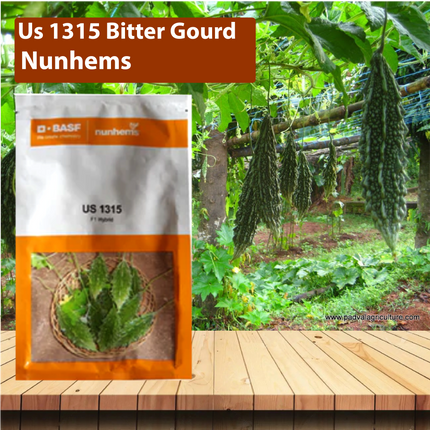Description
Nunhems US 1315 Bitter Gourd Seeds are High-yielding bitter gourd with excellent shipping tolerance. They are a great option for growers looking for a productive and reliable bitter gourd variety. These F1 hybrid seeds produce plants with strong vigor, ensuring a bountiful harvest.
Key Features:
-
High Yield: US 1315 boasts a very high yield, maximizing your harvest potential.
-
Long Crop Longevity: The plants produce fruits over a long period, allowing you to enjoy fresh bitter gourd for an extended season.
-
Excellent Shipping Tolerance: The dark green fruits have strong spines, protecting them from damage during transportation, ideal for long-distance shipping.
-
Attractive Appearance: The gourds have a striking dark green color, making them visually appealing to consumers.
-
Fast Maturing: The fruits mature in just 50-55 days after transplanting.
Benefits:
-
Increased Profits: High yields and extended harvest season translate to greater profits for growers.
-
Reduced Waste: The fruits' durability during transport minimizes spoilage and waste.
-
Market Demand: The attractive appearance and excellent shipping tolerance make US 1315 a preferred choice among traders and consumers.
-
Consumer Satisfaction: The consistent shape and dark green color enhance the visual appeal of the bitter gourd.
Land Preparation:
-
Choose a Sunny Location: Select a sunny location with well-drained soil. Gourds won't tolerate soggy conditions, so avoid planting them in areas that tend to flood or have poor drainage.
-
Prepare the Soil: The ideal soil for gourds is fertile, well-drained, and loamy or sandy. A soil pH between 6.0 and 7.0 is preferred.
-
Amend the Soil (optional): If your soil is not fertile or well-drained, you can amend it before planting. Here's how: Add organic matter: Apply decomposed manure or compost to the planting area at a rate of 10-12 tons per hectare. You can also add aged manure to the planting holes.
-
Improve drainage: If your soil is heavy clay, you can improve drainage by adding sand or other organic matter. Raised beds are another option for improving drainage in poorly drained soils.
-
Tilling and Weeding: Begin preparing the land 3-4 weeks before planting. Till the soil to a fine tilth, which is a loose, crumbly condition that is easy for plant roots to penetrate. Remove any weeds or debris from the planting area.
Sowing
-
Sowing Nunhems US 1315 Bitter Gourd Seeds prefers warm weather. Aim for planting in the spring or summer months after the danger of frost has passed.
-
Some regions may have a second planting window during the rainy season.
-
Choose high-quality Nunhems US 1315 Bitter Gourd Seeds from a reputable source. Consider factors like variety, maturity time, and disease resistance.
-
Direct Sowing vs. Transplanting:
-
Some gourds, like bottle gourds and luffa, thrive with direct sowing in prepared planting holes.
-
Other varieties, like sponge gourds, may benefit from starting Nunhems US 1315 Bitter Gourd seedlings indoors in pots before transplanting outdoors.
-
Follow the recommended planting depth for your specific gourd variety. It's usually around 1-2 inches deep.
-
Each planting hole should hold the recommended number of Nunhems US 1315 Bitter Gourd seeds for your chosen gourd variety. Thin seedlings later if necessary to maintain proper spacing for mature plants.
-
Water the planting area thoroughly after sowing Nunhems US 1315 Bitter Gourd seedlings to ensure good seed-to-soil contact and promote germination.
Transplanting:
-
Timing is Crucial: Transplant Nunhems US 1315 Bitter Gourd seedlings when they have developed 4-5 true leaves, typically around 2-3 weeks after sowing.
-
Harden Them Up: Before transplanting, harden off your seedlings for a week or two. Gradually expose them to increased sunlight, wind, and cooler temperatures to mimic outdoor conditions. This reduces transplant shock.
-
Prepare the Planting Area: Ensure the chosen location has well-drained, fertile soil amended with compost or manure if needed. Space the planting holes according to your specific Nunhems US 1315 Bitter Gourd variety.
-
Dig Carefully: When removing seedlings from their pots or trays, gently loosen the soil and lift the entire root ball to minimize root damage.
-
Plant at the Right Depth: Dig a hole deep enough to accommodate the seedling's root ball. Plant the seedling so the lowest true leaves are slightly above the soil surface.
-
Water Well: Water the newly transplanted Nunhems US 1315 Bitter Gourd seedlings thoroughly to settle the soil around the roots and eliminate air pockets.
-
Continuing Care: Provide regular watering during the initial establishment period, especially during hot or dry weather. Monitor for signs of transplant shock, such as wilti0ng, and provide shade if necessary.
Harvesting Gourds
-
Look for Signs: Generally, gourds are ready for harvest when the stem begins to brown and dry out. The skin may also change color, becoming dull or developing a yellowish tinge for some varieties.
-
Tenderness Test (for culinary gourds): For gourds consumed fresh, gently press the skin with your thumb. If it yields slightly, it's ready for picking. A hard, unyielding skin indicates it needs more time.
-
Sharp is Best: Use sharp pruners or shears to cut the gourd from the vine. Leave a short stem attached (about 1-2 inches) to help prevent rot during storage.
-
Timing is Key: For continuous harvest, pick gourds regularly at the recommended stage. This encourages the plant to produce more fruits. Leaving gourds on the vine for too long can hinder further production.
-
Avoid Frost: Don't wait for frost to harvest your gourds. Frost can damage the fruits and shorten their storage life.
-
Drying Gourds: If you're harvesting gourds for crafting purposes, allow them to dry completely on the vine before picking. This can take several weeks. Signs of dryness include a completely brown and papery stem and a lightweight feel to the gourd.
-
Ripening: If your melons are slightly underripe, you can try to ripen them at room temperature for a day or two. However, don't expect them to ripen significantly if they're picked too early.
